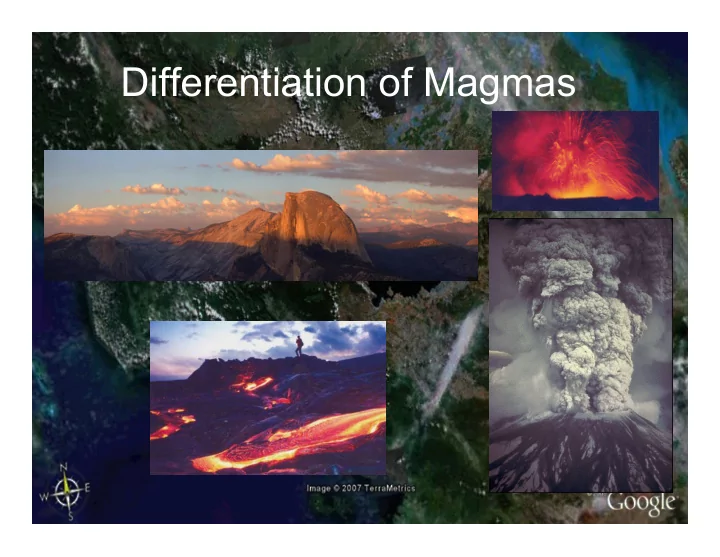

Differentiation of Magmas
Chemical variations - magmas Bulk Upper Crust Figure 16-6. From Winter (2001) An Introduction to Igneous and Metamorphic Petrology. Prentice Hall.
Distillation process • Extract “ Crust ” from the mantle Magma differentiation Mantle Crust
Magmatic Differentiation • Any process by which a magma is able to diversify and produce a magma or rock of different composition • Requirements 1. Create a compositional difference between 2 or more phases 2. Preserves the chemical difference by physically separating the chemically distinct portions
Magmatic distillation • Most important process: – Crystal liquid separation in magma reservoirs • Others also play a role – Degassing (gas escape) – Liquid immiscibility
Separating liquids from solids in a gravity field 1. At low crystallinity ü High density crystals settle down 2. At high crystallinity: ü Low density liquid moves up
Crystallization or melting? • Down temperature = fractional crystallization • Up temperature = partial melting Magma B Magma A Temperature
Crystallization Mantle Crust
Physics of phase separation? 1. Crystal sinking in a pool of largely liquid magma
Stokes ’ Law 2 - V 2gr ( ρ ρ ) s l = 9 µ V = the settling velocity (m/s) g = the acceleration due to gravity (9.81 m/s 2 ) r = the radius of a spherical particle (m) ρ s = the density of the solid spherical particle (kg/m 3 ) ρ l = the density of the liquid (kg/m 3 ) µ = the viscosity of the liquid (Pa s)
Homework Olivine settling in basalt (m/years)? – Olivine ( ρ s = 3300 kg/m 3 , r = 0.001 m) – Basaltic liquid ( ρ l = 2650 kg/m 3 , µ = 100 Pa s) Plagioclase in rhyolitic melt (m/years)? – feldspars ( ρ l = 2600 kg/m 3 , r = 0.001 m) – Rhyolitic liquid (µ = 10 6 Pa s and ρ l = 2300 kg/m 3 ) Is crystal settling realistic in magmas? Explain why or why not!
Separating liquids from solids in a gravity field 1. At low crystallinity o Crystal settle down 2. At high crystallinity: o Liquid moves up
Liquid extraction from “ mush ”
Partial melting of Earth ’ s crust • As for the mantle, the Earth ’ s crust can melt • Solidus at much lower T (<700 °C) if feldspar-quartz-water are present – Why so low?
The Eutectic Nature of Salt and Water
http://ucalgary.ca/~kmuldrew/cryo_course/cryo_chap6_1.html
Phase diagram with eutectic Ab-Or as a f(P H2O ) Figure 6-17. The Albite-K-feldspar system at various H 2 O pressures. (a) and (b) after Bowen and Tuttle (1950), J. Geol, (c) after Morse (1970) J. Petrol.
Granitic eutectic Figure 18-3. The Ab-Or-Qtz system with the ternary cotectic curves and eutectic minima from 0.1 to 3 GPa. Included is the locus of most granite compositions from Figure 11-2 (shaded) and the plotted positions of the norms from the analyses in Table 18-2. Note the effects of increasing pressure and the An, B, and F contents on the position of the thermal minima. From Winter (2001) An Introduction to Igneous and Metamorphic Petrology. Prentice Hall.
Main source of heat 1. Burial 2. Intrusion of mafic magma
Burial Crustal thickening Figure 18-6. A simple modification of Figure 16-17 showing the effect of subducting a slab of continental crust, which causes the dip of the subducted plate to shallow as subduction ceases and the isotherms begin to “ relax ” (return to a steady-state value). Thickened crust, whether created by underthrusting (as shown) or by folding or flow, leads to sialic crust at depths and temperatures sufficient to cause partial melting. Winter (2001) An Introduction to Igneous and Metamorphic Petrology. Prentice Hall.
Himalayas Figure 18-7. Schematic cross section of the Himalayas showing the dehydration and partial melting zones that produced the leucogranites. After France-Lanord and Le Fort (1988) Trans. Roy. Soc. Edinburgh , 79, 183-195. Winter (2001) An Introduction to Igneous and Metamorphic Petrology. Prentice Hall.
Basalt intrusion
Partially molten rocks Migmatites
Extraction pf liquid at high crystal fraction? Compaction g w k ! (1 )( ) = # ! " # " 0 s l µ ! t h ! h c = $ h " ! 0 c h h " t 0 = = h w (1 ) ! $ # c 0 1 h h (1 e $ ) = # $ m McKenzie, 1984
Collaboration between melting and crystal fractionation • Due to latent heat release during crystallization, the two processes may operate in conjunction • Assimilation Fractional Crystallization (AFC)
Liquid Immiscibility • Liquids do not mix with each other. – E.g., oil and water/vinegar • Silicate-Carbonatite • Sulfide liquids in silicate • Fe-rich basaltic magmas can form two separate liquids - one felsic and rich in SiO 2 , and the other mafic and rich in FeO.
Diversification of magma • Magma mixing : recognized at least since Bunsen (1851)
Comingled basalt-Rhyolite Mt. McLoughlin, Oregon Figure 11-8 From Winter (2001) An Introduction to Igneous and Metamorphic Petrology. Prentice Hall Basalt pillows accumulating at the bottom of a in granitic magma chamber, Vinalhaven Island, Maine
Differentiation processes Magma chambers Magma chamber
Recommend
More recommend